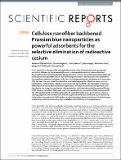| dc.contributor.author | Vipin, Adavan Kiliyankil | |
| dc.contributor.author | Fugetsu, Bunshi | |
| dc.contributor.author | Sakata, Ichiro | |
| dc.contributor.author | Isogai, Akira | |
| dc.contributor.author | Endo, Morinobu | |
| dc.contributor.author | Li, Mingda | |
| dc.contributor.author | Dresselhaus, Mildred | |
| dc.date.accessioned | 2017-05-15T13:34:26Z | |
| dc.date.available | 2017-05-15T13:34:26Z | |
| dc.date.issued | 2016-11 | |
| dc.date.submitted | 2016-08 | |
| dc.identifier.issn | 2045-2322 | |
| dc.identifier.uri | http://hdl.handle.net/1721.1/109075 | |
| dc.description.abstract | On 11 March 2011, the day of the unforgettable disaster of the 9 magnitude Tohoku earthquake and quickly followed by the devastating Tsunami, a damageable amount of radionuclides had dispersed from the Fukushima Daiichi’s damaged nuclear reactors. Decontamination of the dispersed radionuclides from seawater and soil, due to the huge amounts of coexisting ions with competitive functionalities, has been the topmost difficulty. Ferric hexacyanoferrate, also known as Prussian blue (PB), has been the most powerful material for selectively trapping the radioactive cesium ions; its high tendency to form stable colloids in water, however, has made PB to be impossible for the open-field radioactive cesium decontamination applications. A nano/nano combinatorial approach, as is described in this study, has provided an ultimate solution to this intrinsic colloid formation difficulty of PB. Cellulose nanofibers (CNF) were used to immobilize PB via the creation of CNF-backboned PB. The CNF-backboned PB (CNF/PB) was found to be highly tolerant to water and moreover, it gave a 139 mg/g capability and a million (106) order of magnitude distribution coefficient (Kd) for absorbing of the radioactive cesium ion. Field studies on soil and seawater decontaminations in Fukushima gave satisfactory results, demonstrating high capabilities of CNF/PB for practical applications. | en_US |
| dc.description.sponsorship | National Science Foundation (U.S.) (DMR-1507806) | en_US |
| dc.language.iso | en_US | |
| dc.publisher | Nature Publishing Group | en_US |
| dc.relation.isversionof | http://dx.doi.org/10.1038/srep37009 | en_US |
| dc.rights | Creative Commons Attribution 4.0 International License | en_US |
| dc.rights.uri | http://creativecommons.org/licenses/by/4.0/ | en_US |
| dc.source | Nature | en_US |
| dc.title | Cellulose nanofiber backboned Prussian blue nanoparticles as powerful adsorbents for the selective elimination of radioactive cesium | en_US |
| dc.type | Article | en_US |
| dc.identifier.citation | Vipin, Adavan Kiliyankil; Fugetsu, Bunshi; Sakata, Ichiro; Isogai, Akira; Endo, Morinobu; Li, Mingda and Dresselhaus, Mildred S. “Cellulose Nanofiber Backboned Prussian Blue Nanoparticles as Powerful Adsorbents for the Selective Elimination of Radioactive Cesium.” Scientific Reports 6, no. 1 (November 2016). | en_US |
| dc.contributor.department | Massachusetts Institute of Technology. Department of Mechanical Engineering | en_US |
| dc.contributor.department | Massachusetts Institute of Technology. Department of Physics | en_US |
| dc.contributor.mitauthor | Li, Mingda | |
| dc.contributor.mitauthor | Dresselhaus, Mildred | |
| dc.relation.journal | Scientific Reports | en_US |
| dc.eprint.version | Final published version | en_US |
| dc.type.uri | http://purl.org/eprint/type/JournalArticle | en_US |
| eprint.status | http://purl.org/eprint/status/PeerReviewed | en_US |
| dspace.orderedauthors | Vipin, Adavan Kiliyankil; Fugetsu, Bunshi; Sakata, Ichiro; Isogai, Akira; Endo, Morinobu; Li, Mingda; Dresselhaus, Mildred S. | en_US |
| dspace.embargo.terms | N | en_US |
| dc.identifier.orcid | https://orcid.org/0000-0001-8492-2261 | |
| mit.license | PUBLISHER_CC | en_US |
| mit.metadata.status | Complete | |
